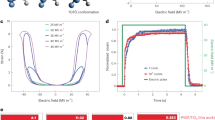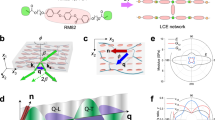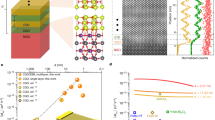Abstract
Mechanisms for converting electrical energy into mechanical energy are essential for the design of nanoscale transducers, sensors, actuators, motors, pumps, artificial muscles, and medical microrobots. Nanometre-scale actuation has to date been mainly achieved by using the (linear) piezoelectric effect in certain classes of crystals (for example, quartz), and ‘smart’ ceramics such as lead zirconate titanate. But the strains achievable in these materials are small—less than 0.1 per cent—so several alternative materials and approaches have been considered. These include grafted polyglutamates1 (which have a performance comparable to quartz), silicone elastomers2 (passive material—the constriction results from the Coulomb attraction of the capacitor electrodes between which the material is sandwiched) and carbon nanotubes3 (which are slow). High and fast strains of up to 4 per cent within an electric field of 150 MV m-1 have been achieved by electrostriction (this means that the strain is proportional to the square of the applied electric field) in an electron-irradiated poly(vinylidene fluoride-trifluoroethylene) copolymer4. Here we report a material that shows a further increase in electrostriction by two orders of magnitude: ultrathin (less than 100 nanometres) ferroelectric liquid-crystalline elastomer films that exhibit 4 per cent strain at only 1.5 MV m-1. This giant electrostriction was obtained by combining the properties of ferroelectric liquid crystals with those of a polymer network. We expect that these results, which can be completely understood on a molecular level, will open new perspectives for applications.
This is a preview of subscription content, access via your institution
Access options
Subscribe to this journal
Receive 51 print issues and online access
$199.00 per year
only $3.90 per issue
Buy this article
- Purchase on Springer Link
- Instant access to full article PDF
Prices may be subject to local taxes which are calculated during checkout



Similar content being viewed by others
References
Jaworek, T., Neher, D., Wegner, G., Wieringa, R. H. & Schouten, A. J. Electromechanical properties of an ultrathin layer of directionally aligned helical polypeptides. Science 279, 57–60 (1998).
Pelrine, R., Kornbluh, R., Pei, Q. & Joseph, J. High-speed electrically actuated elastomers with strain greater than 100%. Science 287, 836–839 (2000).
Baughman, R. H. et al. Carbon nanotube actuators. Science 284, 1340–1344 (1999).
Zhang, Q. M., Bharti, V. & Zhao, X. Giant electrostriction and relaxor ferroelectric behavior in electron-irradiated poly(vinylidene fluoride-trifluoroethylene) copolymer. Science 280, 2101–2104 (1998).
Zentel, R. Liquid crystalline elastomers. Angew. Chem. Int. Edn Engl. 28, 1407–1415 (1989).
Wong, G. C. L. et al. Induced long range order in crosslinked ‘one-dimensional’ stacks of fluid monolayers. Nature 389, 576–579 (1997).
Lagerwall, S. T. Ferroelectric and Antiferroelectric Liquid Crystals (Wiley-VCH, Weinheim, 1999).
Terentjev, E. M. & Warner, M. Continuum theory of ferroelectric smectic C* elastomers. J. Phys. II France 4, 849–858 (1994).
Clark, N. A. & Lagerwall, S. T. Submicrosecond bistable electro-optic switching in liquid crystals. Appl. Phys. Lett. 36, 899–901 (1980).
Jákli, A. & Saupe, A. Field-induced thickness change of ferroelectric liquid crystal films. Phys. Rev. E 53, R5580–R5583 (1996).
Garoff, S. & Meyer, R. B. Electroclinic effect at the A-C phase change in a chiral liquid crystal*. Phys. Rev. Lett. 38, 848–851 (1977).
Rappaport, A. G. et al. X-ray observation of electroclinic layer constriction and rearrangement in a chiral smectic-A liquid crystal. Appl. Phys. Lett. 67, 362–364 (1995).
Gebhard, E. & Zentel, R. Ferroelectric liquid crystalline elastomers. Macromol. Chem. Phys. 201, 902–910 (2000).
Schüring, H., Stannarius, R., Tolksdorf, C. & Zentel, R. Liquid crystal elastomer balloons. Macromolecules (submitted).
Mach, P., Huang, C. C. & Nguyen, H. T. Dramatic effect of single-atom replacement on the surface tension of liquid-crystal compounds. Phys. Rev. Lett. 80, 732–735 (1998).
Johnson, P. M., Pankratz, S., Mach, P., Nguyen, H. T. & Huang, C. C. Optical reflectivity and ellipsometry studies of the Sm-Cα* phase. Phys. Rev. Lett. 83, 4073–4076 (1999).
Zhao, J., Zhang, Q. M., Kim, N. & Shrout, T. Electromechanical properties of relaxor ferroelectric lead magnesium niobate-lead magnesium titanate ceramics. Jpn J. Appl. Phys 34, 5658–5663 (1995).
Poths, H., Anderson, G., Skarp, K. & Zentel, R. Fast electroclinic switching in a ferroelectric LC Polysiloxane. Adv. Mater. 4, 792–794 (1992).
Kremer, F. Electromechanical and/or mechanoelectrical converter. German Patent No. 196 36 909 (1998).
Semmler, K. & Finkelmann, H. Mechanical field orientation of chiral smectic C-polymer networks. Macromol. Chem. Phys. 196, 3197–3205 (1995).
Lehmann, W. et al. The electromechanical effect in mechanically oriented SC*-elastomers examined by means of an ultra-stable Michelson interferometer. Ferroelectrics 208–209, 373–383 (1998).
Lehmann, W. et al. Direct and inverse electromechanical effect in ferroelectric liquid crystalline elastomers. J. Appl. Phys. 86, 1647–1652 (1999).
Kremer, F. et al. Piezoelectricity in ferroelectric liquid crystalline elastomers. Polym. Adv. Technol. 9, 672–677 (1998).
Acknowledgements
We thank R. Stannarius and D. Neher for discussions, and the “Innovationskolleg Phänomene an den Miniaturisierungsgrenzen” at the University of Leipzig for support.
Author information
Authors and Affiliations
Corresponding author
Supplementary information
Rights and permissions
About this article
Cite this article
Lehmann, W., Skupin, H., Tolksdorf, C. et al. Giant lateral electrostriction in ferroelectric liquid-crystalline elastomers. Nature 410, 447–450 (2001). https://doi.org/10.1038/35068522
Received:
Accepted:
Issue Date:
DOI: https://doi.org/10.1038/35068522
This article is cited by
-
Reconfigurable and NIR-responsive shape memory polymer containing bipheunit units and graphene
Polymer Journal (2022)
-
Biferroelectricity of a homochiral organic molecule in both solid crystal and liquid crystal phases
Nature Communications (2022)
-
Atomically engineered interfaces yield extraordinary electrostriction
Nature (2022)
-
Electrical switching of high-performance bioinspired nanocellulose nanocomposites
Nature Communications (2021)
-
Morphing of liquid crystal surfaces by emergent collectivity
Nature Communications (2019)
Comments
By submitting a comment you agree to abide by our Terms and Community Guidelines. If you find something abusive or that does not comply with our terms or guidelines please flag it as inappropriate.



